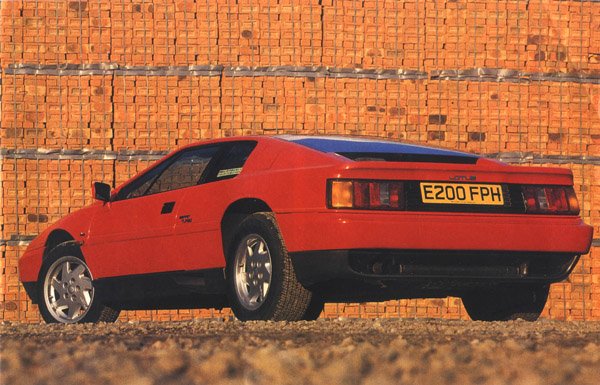
Motoring & Leisure
The Lotus Position - February 1988
Click on image to enlarge
Coming under the aegis of General Motors has created a different mood at Lotus. The liason has opened doors to the Norfolk-based specialist sports car maker that enable it to continue doing what it is best at, but doing it now safe in the knowledge that GM is a guarantor should Lotus need access to financial resources for advanced work. Previously Lotus often found themselves with the expertise but without the all important purse strings.
With this new found confidence in the future, a mere 18 months was all it took the company's in house design team to design a replacement for the once stunningly futuristic but now unfashionably angular Giugiaro penned wedge that we first saw in 1976.
The new Lotus Esprit Turbo has found the soft, rounded lines that flow in a harmonious composition with air intakes that are part of the organism rather than an afterthought – unlike some of it's competitors. Yet this accomplishment produces no trace of sacrifice in the rakishness of a car that has to look as it is moving when it is at rest. Intensive wind-tunnel work has produced a vehicle that is at once more stable at speed and yet more slippery. The Turbo cleaves the air with a 0.33Cd while it's naturally aspirated counterpart is under 10 per cent worst off. An interesting feature of the Turbo's design is the glass panel that sits astride the rear buttresses, but stops short of the rear deck. This device is partly responsible for the improved aerodynamics and also improves the visual integrity of the car when viewed from certain angles.
Click on image to enlarge
A rear shot of the Peter Stevens design Lotus Esprit
The fitting of such a panel would be tempt fate in a body-shell subject to much flexing, so it is a tribute to the rigidity of the new shell that no such problems exist. The old Esprit was made from hand-laid GRP, the new car followed the Lotus patented VARI (vacuum assisted resin injection) route like the Excel and picks up the speed, quality and stiffness in the process. The mechanical underpinnings are much the same, but the spring and damper rates of the double wishbone coil sprung independent suspension have been altered and the rear disc brakes moved out board. Lighter alloy wheels more than make up for an on-paper increase in un-sprung weight.
The four cylinder all-alloy 16 valve engine remains unchanged save for the use of a water-cooled turbocharger with integral wastegate. Power is up by 5bhp to 215bhp at 6,250rpm with 220lb/ft of torque at 4,200rpm. The twin carburettored Esprit is good for 172bhp at 6,250 rpm and 163 lb/ft of torque at 5,000 rpm which gives the car a claimed top speed of 138mph and 0-60 of 6.5 seconds. The Turbo adds 14mph to the top speed while cutting 1.2 seconds off the acceleration benchmark.
The original Esprit was a tight fit for anyone who dared aspire to tallness and if height could be a problem, then so could girth. All that has changed, and an all new more roomy and yet cosy interior that is at once more modern, more ergonomic and easier to see out of greets the lucky driver and passenger. The very tall still have a problem, but for the majority, the car is close to perfect. The revised dashboard now reveals its information more easily and the general fit and finish of the hide and carpet is pleasing as it should be on a low volume production car costing £22,950 without Turbo, £28,900 with.
The new Esprit and Esprit Turbo have taken the essence of the original and honed it to a fine point. The car now has a blend of qualities that like a good wine is mature, synergetic and in balance. That balance brings to mind a lesson that the late Colin Chapman, founder of Lotus Cars, was taught in engineering school. "It is easy to make a bridge stand; it is difficult to make it just stand."
Words by Ian Kuah

